 Pirates and Privateers Pirates and Privateers
The History of Maritime
Piracy
Cindy Vallar, Editor
& Reviewer
P.O. Box 425,
Keller, TX 76244-0425
    
Law &
Order: Pirate Edition
by Cindy Vallar
Insidious
and pernicious. These two words can be applied to
pirates throughout history. One of the earliest
attempts to eradicate sea raiders happens in 694 BC
when Sennacherib, the king of
Assyria, tries to do so. The best-known offensive
against them occurs in 67 BC, when the Roman Senate
sanctions Gnaeus Pompeius Magnus (Pompey
the Great) to gather 270 vessels and sweep across
the Mediterranean to wipe out pirates and their
bases. The milestone in these attacks takes place on
Anatolia’s coast, when Pompeius and his men slay
10,000 pirates and seize 400 ships, but they also
help the survivors transform themselves into
farmers. In between these two events, Alexander the Great implements
his own suppression endeavors in 330 BC. He just
doesn’t expect to find a sea raider with enough
gumption to stand up to him.
 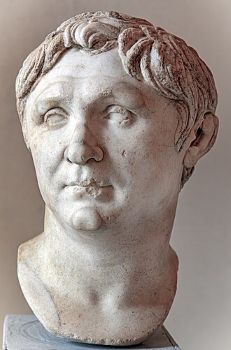 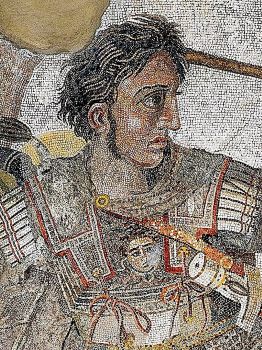
Sennacherib (Cast
of a rock relief from the foot of Cudi Dağı,
near Cizre and now exhibited in Landshut,
Germany)
[Source: Timo Roller, 2015 at Wikimedia Commons]
Bust of Pompeius the Great
(Museo archeologico nazionale in Venice) by
unknown artist of AD first century
[Source: Didier Descouens, 2023 at Wikimedia Commons]
Section of mosaic depicting
Alexander the Great at the House of the Faun
on Pompeii
[Source: Unknown artist, circa 100 BC, Wikimedia Commons]
In De civitate Dei contra paganos (The
City of God), Saint Augustine recounts an
interview between Alexander the Great and a captured
pirate named Diomedes. The Macedonian king asks why
Diomedes dares to rob people at sea. Since execution
awaits the pirate, he has nothing to lose and poses
a cheeky question instead: What gives Alexander the
right to invade and conquer other lands? Diomedes
sees no difference between what they both do.
Alexander, who has wealth and power, does what he
wants and gets away with “pirating” other countries.
Whereas he, lowly Diomedes, is deemed a sea robber
because he chooses to do the same thing on a much
smaller scale. Seeing the truth, or wisdom, in what
Diomedes says, Alexander offers the pirate a pardon
so he can begin life anew.
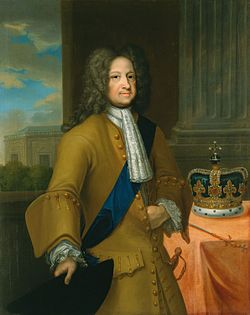 Excusing
a crime without exacting a penalty might seem like
an unusual way to suppress piracy, but sovereigns
around the world offered such pardons multiple times
throughout history. King George I of England, for
example, signed a proclamation offering pirates an Act of Grace during the most
prolific period of marauding in the early eighteenth
century. His predecessor, James I extended pardons to
pirates in Ireland in 1609; two years later, he
agreed to pardon other pirates, such as Peter Easton, but corruption
within the Emerald Isle eventually led James’s Privy
Council to add a stipulation. Any pirate hopeful of
a pardon must “repair to some port in England” to
obtain one. (Appleby, Affairs, 81) Excusing
a crime without exacting a penalty might seem like
an unusual way to suppress piracy, but sovereigns
around the world offered such pardons multiple times
throughout history. King George I of England, for
example, signed a proclamation offering pirates an Act of Grace during the most
prolific period of marauding in the early eighteenth
century. His predecessor, James I extended pardons to
pirates in Ireland in 1609; two years later, he
agreed to pardon other pirates, such as Peter Easton, but corruption
within the Emerald Isle eventually led James’s Privy
Council to add a stipulation. Any pirate hopeful of
a pardon must “repair to some port in England” to
obtain one. (Appleby, Affairs, 81)
Pardons were often merely one tool in the
authorities’ arsenal. If a pirate chose to ignore
the pardon and resume plundering, he would be hunted
down, prosecuted, and punished. This was what
happened to Charles Vane, who sneered at King
George’s pardon, and Calico Jack Rackham, who signed
the pardon but returned to his old ways.
When Woodes Rogers assumed the
governorship of the Bahamas in 1718, part of his
mission was to eradicate piracy. The islands were
both a haven and a staging ground for the
scoundrels, but not everyone was amenable to
returning to society and obeying the rules and
regulations that identified what a person could or
could not. Vane warned Rogers that he would only
surrender on his terms:
That you
will suffer us to dispose of all our Goods now
in our Possession. Likewise, to act as we think
fit with every Thing belonging to us, as his
Majesty’s Act of Grace specifies. (Defoe,
142)
 Woodes
had no intention of giving the pirate the upper
hand, and after creating some mischief, Vane and his
men fled the Bahamas. Various pirate hunters, such
as Colonel William Rhett of South
Carolina who captured Stede Bonnet, attempted to
track down Vane and bring him in, but none
succeeded. His initial comeuppance came at the hands
of his fellow pirates, who ousted him as captain and
sent him off in a boat with some loyal followers.
Mother Nature delivered her own justice when a
hurricane destroyed this vessel. Only two men, Vane
being one of them, survived the ordeal. Rescue
seemed close at hand when a ship happened upon the
uninhabited island, but her captain recognized Vane
and, knowing his untrustworthy nature, sailed away.
Sometime later, this same captain came aboard
another ship and recognized one of the seamen. Vane
was clapped in irons and taken to Port Royal,
Jamaica, where he was hanged in 1721.1
His corpse was gibbeted on Gun Cay as a warning to
others. Woodes
had no intention of giving the pirate the upper
hand, and after creating some mischief, Vane and his
men fled the Bahamas. Various pirate hunters, such
as Colonel William Rhett of South
Carolina who captured Stede Bonnet, attempted to
track down Vane and bring him in, but none
succeeded. His initial comeuppance came at the hands
of his fellow pirates, who ousted him as captain and
sent him off in a boat with some loyal followers.
Mother Nature delivered her own justice when a
hurricane destroyed this vessel. Only two men, Vane
being one of them, survived the ordeal. Rescue
seemed close at hand when a ship happened upon the
uninhabited island, but her captain recognized Vane
and, knowing his untrustworthy nature, sailed away.
Sometime later, this same captain came aboard
another ship and recognized one of the seamen. Vane
was clapped in irons and taken to Port Royal,
Jamaica, where he was hanged in 1721.1
His corpse was gibbeted on Gun Cay as a warning to
others.
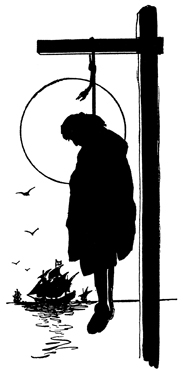 Once
Vane’s quartermaster, Rackham opted to take
advantage of the king’s amnesty in 1719. Whether
pillaging proved too tempting or difficulties
concerning Anne Bonny’s marital status forced Jack
to rethink his decision, he returned to marauding.
This resumption made him fair game for pirate
hunters, and he was captured in November 1720 by
Captain Jonathan Barnett. Found guilty at his trial
in Port Royal, he, too, danced the hempen jig before
being placed on display at Deadman’s Cay (now
Rackham’s Cay). Once
Vane’s quartermaster, Rackham opted to take
advantage of the king’s amnesty in 1719. Whether
pillaging proved too tempting or difficulties
concerning Anne Bonny’s marital status forced Jack
to rethink his decision, he returned to marauding.
This resumption made him fair game for pirate
hunters, and he was captured in November 1720 by
Captain Jonathan Barnett. Found guilty at his trial
in Port Royal, he, too, danced the hempen jig before
being placed on display at Deadman’s Cay (now
Rackham’s Cay).
Unlike the codes by which pirates operated, which
applied equally to each and every pirate within a
crew, implementation of land-based laws was
sometimes dependent on one’s station in life. The Killigrews of Cornwall had
deep ties to the ruling Tudors, and their misdeeds
were often overlooked or treated more like slaps on
the wrist. Until some Spaniards decided the
Killigrews had gone too far and took their case to Elizabeth I. An international
incident was not what the queen wanted, so Lady Mary
Killigrew and two of her servants were arrested.
Whereas Lady Mary was pardoned, her servants were
hanged.
When Westerners came to Asian waters, they brought
with them their concept of what constituted piracy.
This notion was alien to Asians because the word
“pirate” was unknown, and their deeds were not seen
in the same way that they were in Europe. Chinese,
for example, had a number of words that pertained to
those who raided at sea – haizei, haidao,
haikou, and yangfei, for example –
but none of these were specifically “pirates” as
Westerners thought of these plunderers. Although sea
people did rob and blackmail victims, it was common
for a sea merchant and a pirate to be one and the
same, depending on circumstances at home. One reason
for this was that at times sea bans (haijan)
were decreed, which essentially shut down maritime
trade, especially between China and other countries.
Imperial thinking was that without such commerce,
piracy would end, except Emperor Zhu Gaochi (also known
as the Hongxi Emperor) found out differently after
imposing one such ban in the early 1400s. No trade
actually prompted more smuggling and piracy. This
gave rise to men like Zheng Zhilong, a powerful and
successful merchant, pirate, smuggler, and sea lord
of the seventeenth century. He was later executed
but not for his piracy. He was beheaded because his
son refused to surrender to the Qing officials who
ruled China.
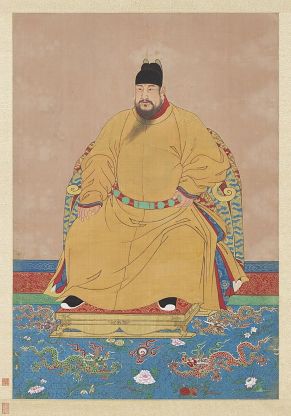 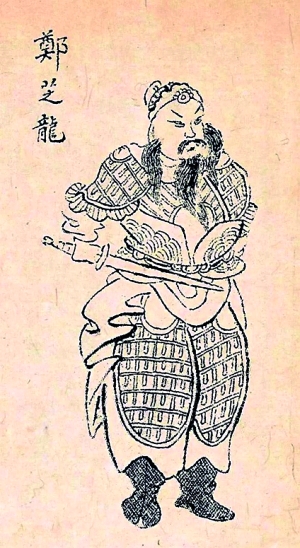
Emperor Zhu Gaochi, also known
as the Hongxi Emperor, by unknown artist of
the Ming Dynasty
(Source: Wikimedia Commons)
Zheng Zhilong in Taiwain Waiji,
1699 (Source: Wikimedia Commons)
During the Qing Dynasty, pirates (zheng dao)
broke the law by raiding ships and coastal villages.
After such violent attacks, these gang members
shared whatever illicit booty they had acquired. The
punishment for those convicted of piracy was zhan
lijue xiaoshi (beheading of the pirate and
displaying of his head, much like Westerners
displayed the corpses of executed pirate captains).
So many pirates plagued China’s waters in 1796, that
the emperor gave authorities permission to
immediately execute convicted pirates rather than
wait for his permission. Some severed heads were
sent to locales where the crimes had been committed
and displayed on pikes or in cages for all to see.
In instances where the crimes were particularly
brutal, lingchi (death
by 1,000 cuts) was deemed more appropriate.
The
criminal is fastened to a rough cross, and the
executioner, armed with a sharp knife, begins by
grasping handfuls from the fleshy parts of the
body, such as the thighs and the breasts, and
slicing them off. After this he removes the
joints and the excrescences of the body one by
one – the nose and ears, fingers and toes. Then
the limbs are cut off piecemeal at the wrists
and the ankles, the elbows and knees, the
shoulders and hips. Finally, the victim is
stabbed to the heart and his head cut off.
(Norman, 225)
According to Qing law, a
pirate plundered vessels at sea or on a river or
employed a boat to go ashore to pillage villages or
other places where people lived. Rather than judge
prisoners for the single crime of piracy, the
authorities viewed each act as a separate offense.
This meant the charges against captured pirates on a
single raid might include abduction, extortion,
homicide, theft, and violence (such as rape or
wounding).
Governor-General Bai Ling believed that “without
rice and gunpowder there would be no pirates.”
(Antony, Like, 129) In 1809, he instituted a
variety of policies to clamp down on piracy. One
required vessels carrying rice to be armed and
protected by soldiers; they also had to sail in
convoys of eight to ten boats. Some rice was
transported overland instead of by water. Detailed
records of gunpowder needed to be kept, and those
who worked with the explosive were kept under close
watch. The pirates’ reactions were not what Bai Ling
expected. Instead, they turned violent and for over
two months, navigated inland water routes, pillaging
and kidnapping. When General Xu Tinggui put in at
Weijiamen in July, the pirates staged an ambush.
More than 1,000 soldiers were slain, including
General Xu. Seeing the writing on the wall, Bai Ling
rethought his policies and decided it was better to
pacify the pirates than rile them. His offers of
pardon resulted in more than 1,500 ceasing to live a
life of pillaging and violence. Among them were Zheng Yi Sao and Zhang Bao;
with their surrenders, the great pirate
confederation ceased to exist.
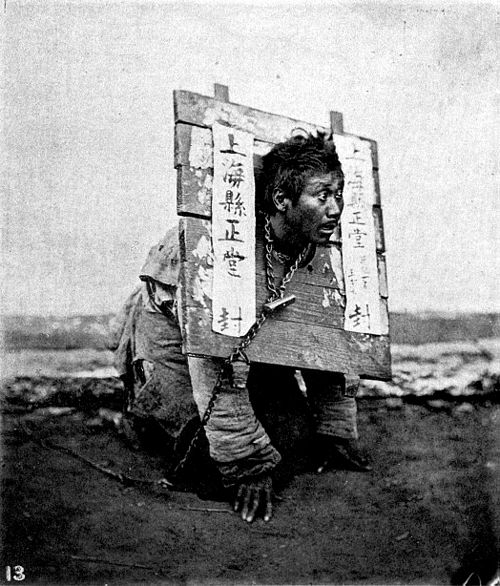 Regardless
of time or place, authorities ultimately understood
that suppressing piracy wasn’t as simple as just
getting rid of pirates. These violators of the law
did not work in a void; they had help. To fully
succeed in eradicating piracy, those who assisted
the pirates had to be dealt with as well. During the
Qing dynasty, Chinese authorities in coastal
communities referred to collaborators who supplied
goods and services to the pirates as jianmin (wicked
people) and lanzai (worthless fellows).
Thousands of these abettors were arrested and tried
between 1780 and 1810. Those found guilty either had
to wear a cangue for a time or
suffer death, depending on just how much this person
helped the pirates.2 Regardless
of time or place, authorities ultimately understood
that suppressing piracy wasn’t as simple as just
getting rid of pirates. These violators of the law
did not work in a void; they had help. To fully
succeed in eradicating piracy, those who assisted
the pirates had to be dealt with as well. During the
Qing dynasty, Chinese authorities in coastal
communities referred to collaborators who supplied
goods and services to the pirates as jianmin (wicked
people) and lanzai (worthless fellows).
Thousands of these abettors were arrested and tried
between 1780 and 1810. Those found guilty either had
to wear a cangue for a time or
suffer death, depending on just how much this person
helped the pirates.2
During the uptick in piracy after 1780, officials
imposed stricter penalties. Yang Yawo was arrested
as an abettor in 1789, but Governor-General Jiqing
didn’t think wearing the cangue was a harsh enough
penalty to make him cease and desist once the device
was removed. Instead, Yang spent three years in
prison, forced to do hard labor. He also received
100 lashes from a bamboo stick. Once he endured
these punishments, the authorities inflicted one
more to guarantee that he never again reverted to
his old ways: relocation further inland. Twenty
years later, Xiao Shique received a similar fate
after being nabbed for selling watermelon to
pirates; his ultimate destination was remote
northeast China near the borders of what is today
known as Inner Mongolia and Russia. At least, these
men survived. Fisherman Yang Pinfu wasn’t so lucky.
Nabbed for selling rice to pirates three separate
times, he literally lost his head.
Mitigating circumstances, such as being forced to
assist pirates, were irrelevant. As far as the
government was concerned, only those who spent their
entire captivity locked away below decks were
released without punishment if rescued. The
remaining captives (beilu zhe) suffered
various forms of punishment.
In the provinces of Fujian and Guangdong, 9,600
people were arrested for piracy, but only 2,803 of
these were actual pirates. Of the remaining 6,797
detainees, all of whom were kidnappees, just 26%
were eventually released without penalty.
Twenty-eight percent had been forced to take part in
raids, which made them accomplices. Pirates
compelled the remaining 46% to do menial tasks. One
such victim was Chen Kaifa, who had been taken by
Zheng Qi. Initially, Chen was assigned menial tasks,
but Zheng decided Chen should act as a lookout (bafeng)
and then he had to help stow the plunder aboard
Zheng’s junk. One time only. Once was enough; in the
eyes of the authorities, the victim was now an
accessory, and he was sentenced to die.
While not considered as guilty as victims like Chen,
even those who brewed tea, hauled on ropes, or
helped to weigh anchor had to be punished. They
received sentences of three years forced labor and
100 whacks with a bamboo rod.
Think such punishments too harsh? Remember the
opening scene of Pirates of the Caribbean: At World’s End. A line
of shackled men, women, and children shuffle towards
the gallows at Port Royal. Each is to be hanged for
abetting piracy. Yes, it is dramatic license, but
Hollywood merely depicts on a grand scale what
eighteenth-century English law decrees. Even an
accomplice is deemed a pirate and is subject to the
same punishment – dancing the hempen jig.
Notes:
1. Although Great Britain
abolished the death penalty in 1965 for those
convicted of murder, people found guilty of piracy
were still eligible for death until 1998.
2. The Merriam-Webster Dictionary
defines the cangue as “a large, flat, square or
rectangular device that was formerly used in some
Asian countries like a portable pillory for
confining the neck and sometimes also the hands as
punishment.” The word “cangue” is French and derives
from the Portuguese word meaning “yoke.” Cangue is
pronounced “kan-gay.”
Resources (The list is so
extensive that I have placed it on a separate page.)
Copyright ©2025 Cindy
Vallar
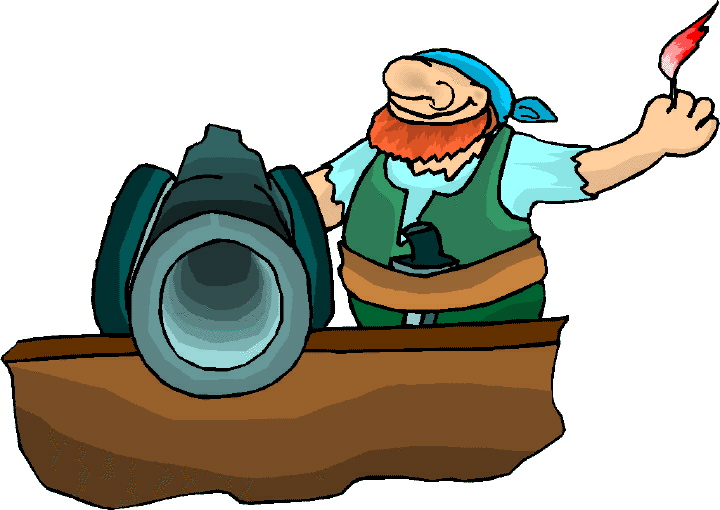
Click to contact me
Background image compliments
of Anke's Graphics |

